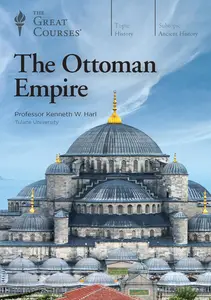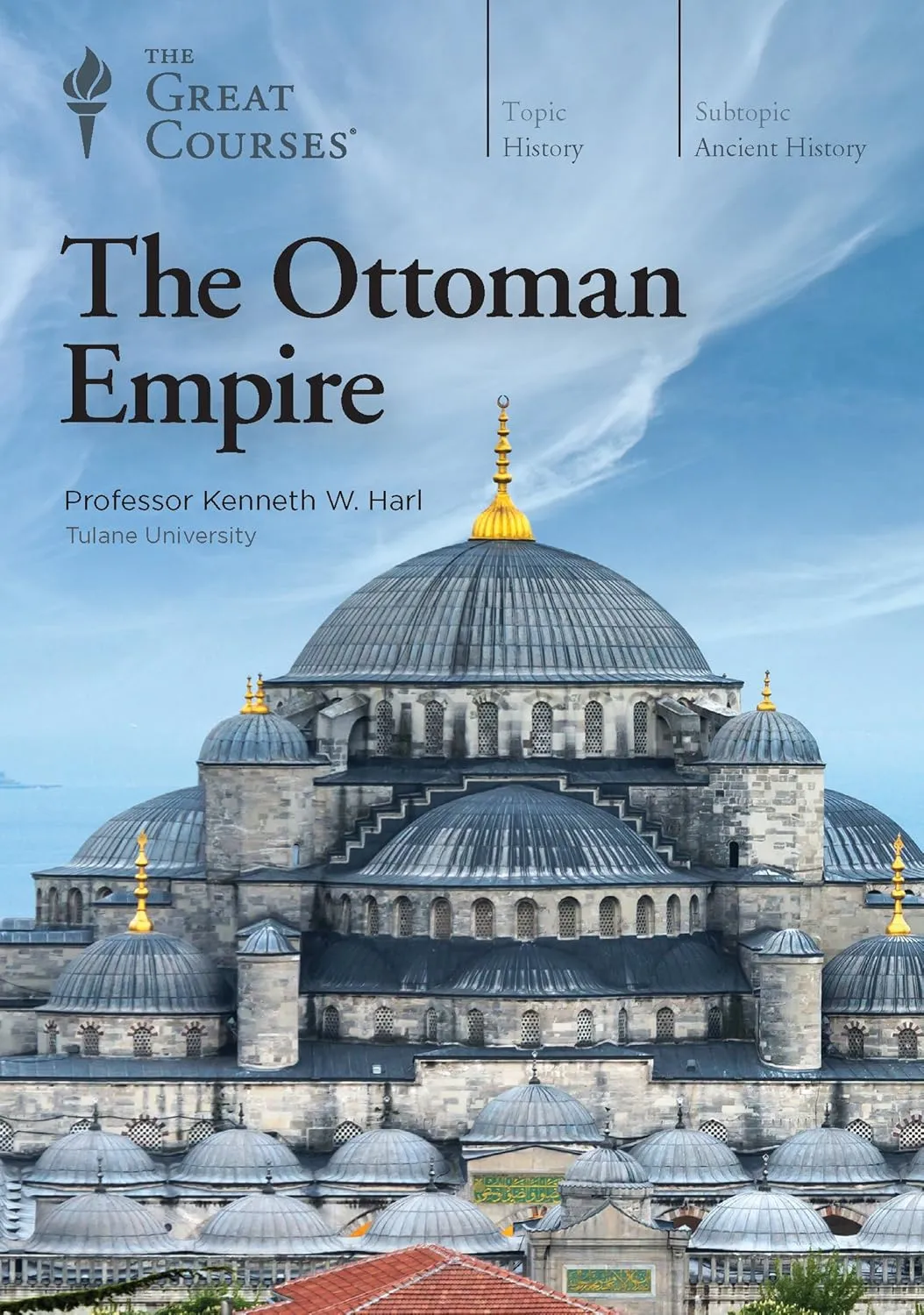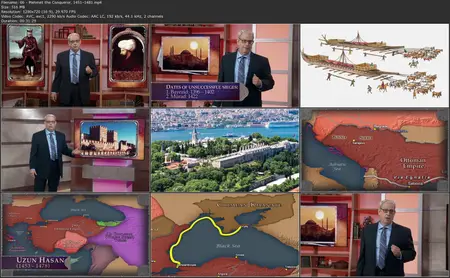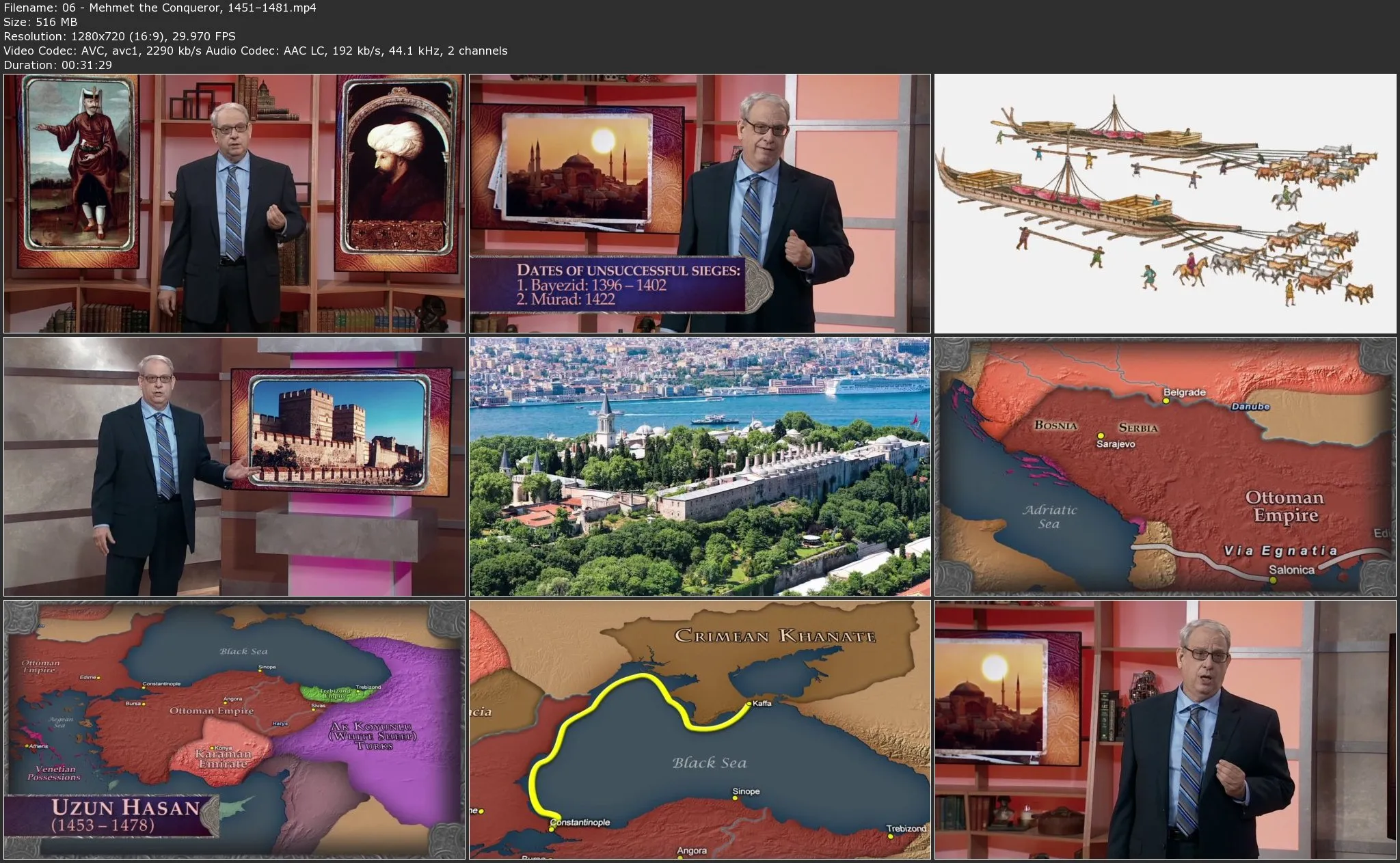TTC Video - The Ottoman Empire
.MP4, AVC, 1280x720, 30 fps | English, AAC, 2 Ch | 18h 55m | 18.07 GB
Lecturer: Kenneth W. Harl, Ph.D. Professor, Tulane University | Course No. 3160
.MP4, AVC, 1280x720, 30 fps | English, AAC, 2 Ch | 18h 55m | 18.07 GB
Lecturer: Kenneth W. Harl, Ph.D. Professor, Tulane University | Course No. 3160
When confronting the future, nations and civilizations always look to the past for guidance, lessons, and a shared sense of purpose and meaning. For the peoples of the Middle East, that immediate past is the Ottoman Empire.
In the West, we often overlook the fact that the achievements of the Ottoman Empire at the zenith of its power matched those of contemporary Western Europe – as well as the other great Islamic states of Safavid Iran and Mughal India. According to Kenneth W. Harl, award-winning professor of Classical and Byzantine history at Tulane University, “the cultural achievements of Ottoman civilization still endure, and they speak of a wealthy and sophisticated Islamic civilization.”
It is by understanding the vast, dramatic story of the Ottoman Empire – from its early years as a collection of raiders and conquerors to its undeniable power in the 15th and 16th centuries to its catastrophic collapse in the wreckage of the First World War – that one can better grasp the current complexities of the Middle East, including geopolitical tensions between Turkey and its Balkan and Middle Eastern neighbors, the sustained political and cultural power of Islam, and the balancing act between religious tradition and cultural modernity.
What made the Ottoman Empire such a match with the empires of the early modern world? What, in fact, made this empire unlike any other in human history? What forces were responsible for shaping this brilliant civilization—and what forces led to its ultimate destruction? These are just some of the questions you’ll explore alongside Professor Harl in The Ottoman Empire. Over the course of 36 historically rich and enlightening lectures, you’ll investigate more than 600 years of history that cover the nature of Ottoman identity, the achievements and oddities of the Sultan’s court, and stories of confrontation and cooperation with the West. The result: a better appreciation for the ways in which the Ottomans created a unique way of life – and how that way of life echoes throughout Europe and across the Middle East.
From “Sublime Porte” to “Sick Man”
To the emissaries of King Francis I in 1536, the Ottoman Empire was called the “Sublime Porte,” referring to the magnificence of the high gate within the empire’s grand Topkapı palace complex. More than 200 years later, Tsar Nicholas I referred to the empire— beginning to lose territory and power—as “the Sick Man of Europe.” Less than 100 years after that, the empire disappeared.
The Ottoman Empire guides you through the rise, flourishing, and fall of one of the most powerful forces in history in a way that makes historical themes and ideas easy to understand. Working chronologically from the empire’s medieval roots to its rebirth as the modern republic of Turkey, Professor Harl groups the lectures around a series of historical moments and themes.
People, Events, and Themes that Made an Empire
Befitting a story of such epic scope and grandeur, every lecture of The Ottoman Empire is a treasure trove of historical nuggets and fascinating insights into the people, events, themes, and locales responsible for shaping the story of this often overlooked empire.
Told with Professor Harl’s characteristic detail and insight, these and other topics are just a few of what you’ll find laid in these 36 lectures.
A Fascinating Story Told by a Great Storyteller
Over the years, Professor Harl has been acclaimed by lifelong learners for his ability to untangle historical complexities and recreate the thrill of making historical connections. As a seasoned member of The Great Courses faculty, his expertise in the Classical and Byzantine eras (including scholarly work on classical Anatolia) makes him the perfect guide through centuries of fascinating history.
The winner of numerous teaching awards, including Tulane University’s Sheldon Hackney Award for Excellence in Teaching (on two occasions), Professor Harl has a preternatural ability to make the intricate layers and interconnections of an entire civilization’s history graspable.
A visually rich course, the video editions of The Ottoman Empire come complete with helpful maps that show the historic expansion (and contraction) of the empire; portraits that put a face with some of the many people you encounter in these lectures; photographs and illustrations of Ottoman architecture, illuminated manuscripts, and historic landscapes; and much more.
Welcome to a fascinating story of the triumph and tragedy, war and peace, intellectual progress and civil insurrection of a great empire that, for all its glory and grandeur, has left an important legacy that will shape the future of the Balkan nation-states, the Turkish Republic, and the Arab world – and those of us in the West as well.
It is by understanding the vast, dramatic story of the Ottoman Empire – from its early years as a collection of raiders and conquerors to its undeniable power in the 15th and 16th centuries to its catastrophic collapse in the wreckage of the First World War – that one can better grasp the current complexities of the Middle East, including geopolitical tensions between Turkey and its Balkan and Middle Eastern neighbors, the sustained political and cultural power of Islam, and the balancing act between religious tradition and cultural modernity.
What made the Ottoman Empire such a match with the empires of the early modern world? What, in fact, made this empire unlike any other in human history? What forces were responsible for shaping this brilliant civilization—and what forces led to its ultimate destruction? These are just some of the questions you’ll explore alongside Professor Harl in The Ottoman Empire. Over the course of 36 historically rich and enlightening lectures, you’ll investigate more than 600 years of history that cover the nature of Ottoman identity, the achievements and oddities of the Sultan’s court, and stories of confrontation and cooperation with the West. The result: a better appreciation for the ways in which the Ottomans created a unique way of life – and how that way of life echoes throughout Europe and across the Middle East.
From “Sublime Porte” to “Sick Man”
To the emissaries of King Francis I in 1536, the Ottoman Empire was called the “Sublime Porte,” referring to the magnificence of the high gate within the empire’s grand Topkapı palace complex. More than 200 years later, Tsar Nicholas I referred to the empire— beginning to lose territory and power—as “the Sick Man of Europe.” Less than 100 years after that, the empire disappeared.
The Ottoman Empire guides you through the rise, flourishing, and fall of one of the most powerful forces in history in a way that makes historical themes and ideas easy to understand. Working chronologically from the empire’s medieval roots to its rebirth as the modern republic of Turkey, Professor Harl groups the lectures around a series of historical moments and themes.
- An Empire is Born: You’ll get an in-depth look at how the Ottoman Empire was first created, and you’ll follow the learning journey it took up through 1632, during the reign of Sultan Murat IV. Along the way, you’ll meet rulers seldom equaled by any other dynasty, including Suleiman the Magnificent – who reigned from 1520 to 1566 and whose iconic rule is still hailed as the apex of Ottoman power.
- The High Ottoman Empire: The classical age of the Ottoman Empire is commonly held as the time between 1453 and 1699. What were its political and religious institutions like? What cultural advancements were made? You’ll dive into two centuries of vitality and originality, covering everything from the imperial economy to Islamic building programs to the development of miniature manuscript paintings.
- When East Met West: Central to the classical age of the Ottoman Empire was its complex relationship with its eastern and Western neighbors, from Safavid Iran to European traders, who both engaged with – and threatened – the traditional Ottoman order. You’ll consider how wars and treaties with the Holy Roman Empire, Venice, Russia and more shifted the balance of power that would pave the way for the empire’s ultimate decline.
- Reform, Collapse, Rebirth: Starting in the late 17th century, the Ottoman Empire began its slow decline, collapse, and partition. After which, a rebirth occurred in the form of the republic of Turkey. Professor Harl unpacks the various historical forces responsible for this, chief among them the First World War and the leadership of Mustafa Kemal.
People, Events, and Themes that Made an Empire
Befitting a story of such epic scope and grandeur, every lecture of The Ottoman Empire is a treasure trove of historical nuggets and fascinating insights into the people, events, themes, and locales responsible for shaping the story of this often overlooked empire.
Told with Professor Harl’s characteristic detail and insight, these and other topics are just a few of what you’ll find laid in these 36 lectures.
- Rumi and the Whirling Dervishes. One of the central figures in the early spiritual transformation of Anatolia was Jalal-ud-din Rumi who, along with his followers, the iconic “whirling dervishes,” used Sufism to create a folk Islam linked to the mores of Anatolian village life.
- Selim the Grim. An ambitious victor of a civil war in 1512, Selim earned his terrifying moniker, Yavuz (“the Grim”), after ordering the execution of all challenges to his rule, including his half-brother, his nephews, and his cousins.
- The Sultan’s Deputies. Something of the Turkish sultan’s right-hand man, the grand viziers, after the mid-16th century, began to assume the foreign policy and administrative power from sultans, who found themselves more involved with spiritual and ceremonial matters.
- Suleiman’s Wars. Not only was Suleiman I one of the Ottoman Empire’s most decisive, influential rulers, he also waged several fierce military campaigns against Safavid Iran (the empire’s main Eastern rival) that were less about territory and more about competing religious claims as to who would lead the Islamic world.
- The Committee of Union and Progress. Between 1909 and 1911, the CUP dominated the Ottoman parliament as something of a shadow government ruling through repression. This is a political model that, Professor Harl notes, would be transmitted to the empire’s successor states in southeastern Europe and the Middle East.
A Fascinating Story Told by a Great Storyteller
Over the years, Professor Harl has been acclaimed by lifelong learners for his ability to untangle historical complexities and recreate the thrill of making historical connections. As a seasoned member of The Great Courses faculty, his expertise in the Classical and Byzantine eras (including scholarly work on classical Anatolia) makes him the perfect guide through centuries of fascinating history.
The winner of numerous teaching awards, including Tulane University’s Sheldon Hackney Award for Excellence in Teaching (on two occasions), Professor Harl has a preternatural ability to make the intricate layers and interconnections of an entire civilization’s history graspable.
A visually rich course, the video editions of The Ottoman Empire come complete with helpful maps that show the historic expansion (and contraction) of the empire; portraits that put a face with some of the many people you encounter in these lectures; photographs and illustrations of Ottoman architecture, illuminated manuscripts, and historic landscapes; and much more.
Welcome to a fascinating story of the triumph and tragedy, war and peace, intellectual progress and civil insurrection of a great empire that, for all its glory and grandeur, has left an important legacy that will shape the future of the Balkan nation-states, the Turkish Republic, and the Arab world – and those of us in the West as well.





